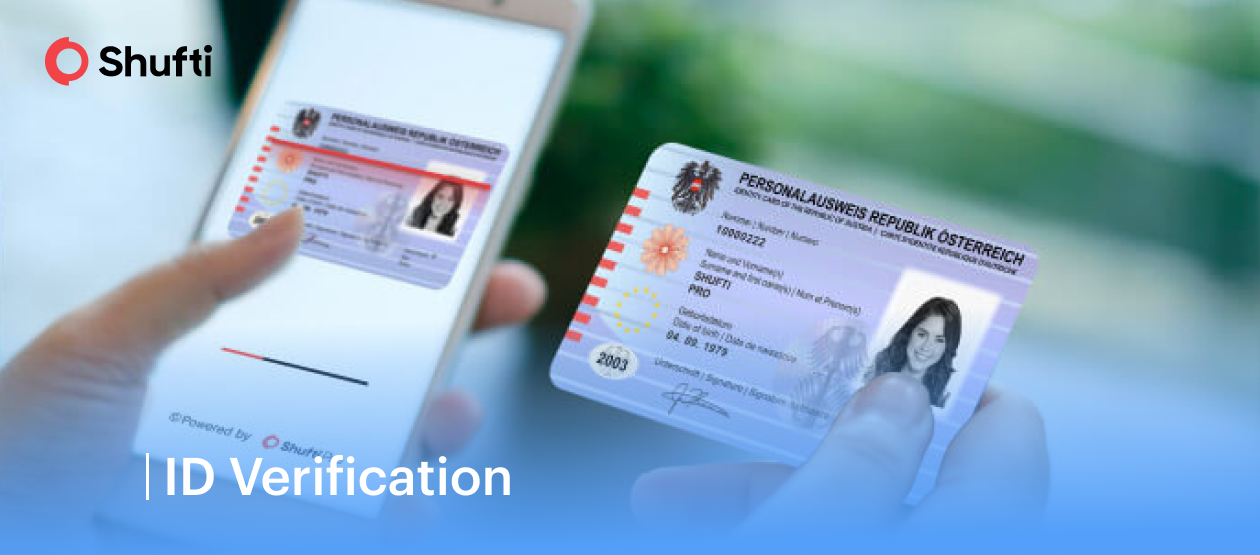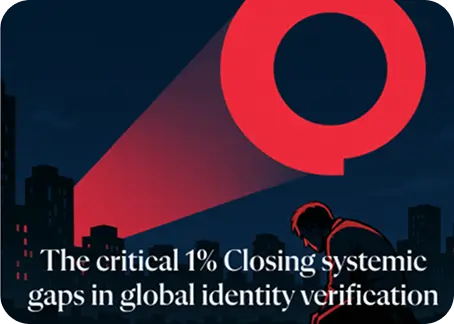ID Verification

Identity (ID) verification is a critical process that establishes trust in the digital age. As businesses around the world continue to adopt remote onboarding and digital first service delivery, using identity documents to verify users has become essential to countering fraud, complying with regulations, and enabling safe interactions. Many industries utilize ID verification, from banks and cryptocurrency exchanges to online marketplaces and iGaming, helping to prevent identity theft, impersonation, and other forms of digital fraud.
At its core, the ID verification process works by validating identity documents, such as a national ID card, passport, or driver’s license, and cross-referencing it with facial biometrics or other user-provided information. This process ensures that the ID is being submitted by the actual user and not a fraudster. Sometimes in order to meet enhanced due diligence standards for high risk industries or actions, supporting documents like bank statements or utility bills might be requested as well.
ID verification is now faster and more secure than ever with the help of innovations in artificial intelligence, machine learning, and blockchain technology. Modern ID verification solutions now use smart algorithms to detect fraudulent documents, perform biometric matching, and liveness detection, all without manual intervention. These advancements have been able to significantly improve the speed and accuracy of identity verification, while enhancing the overall user experience.
How Does ID Verification Work?
Often referred to as digital identity verification or electronic document verification, this process contains three essential stages to authenticate a user’s identity.
1. Acquiring Identity Information
The first step involves individuals providing a clear image of a valid government issued document, such as a passport, driver’s license, or national ID, either by uploading a file or capturing the image using their device’s camera. This document is then securely sent to the verification platform for analysis.
To complement the document and establish a stronger link to the person behind the screen, the user is asked to submit a selfie or record a video. This provides a biometric reference point for the verification system, helping to confirm that the person presenting the ID is the rightful owner.
It is common for liveness detection to be used during this stage which ensures that the person is present in real time and is not using a static image or prerecorded clip. A recent development with this is passive liveness detection, which operates in the background by using subtle indicators like natural light reflection and micromovements, making verification faster and more user-friendly.
2. Analyzing and Verifying the Information
Once the necessary materials are submitted, the verification software moves into core analysis where a number of advanced technologies assess both the document and the biometric data:
- Optical Character Recognition (OCR) is used to extract important personal details, such as full name, date of birth, and document number, from the text of the ID which is then converted into machine-readable data.
- Document analysis tools then analyze the document for signs of forgery or tampering, including checking security features like holograms, watermarks, and MRZ patterns, as well as verifying font consistency and layout integrity.
- Biometric comparison algorithms measure various facial markers to assess if the facial features in the selfie or video match those in the ID photo.
- Liveness detection checks verify that the biometric input was captured from a live person and is not the result of a printed photo or a deepfake.
- Data matching and validation then compare the extracted document data with the data entered by the user or cross-check it against external databases such as governmental registries, PEP/sanctions lists, or other watchlists for added assurance.
3. Delivering Verification Outcomes
After all the validation steps are complete, the system determines a verification result and shares it with the business or platform that requested it. This response usually comes in the form of a pass or a fail, in addition to details such as confidence level, risk indicators, or audit logs. This process often happens within a matter of seconds allowing businesses to quickly onboard new users while maintaining high levels of security.
Key Components of ID Verification
Digital identity verification hinges on two core elements: establishing the authenticity of the presented document and confirming that the person presenting the document is who they say they are.
1. Document Authenticity Checks
Before any information collected from an ID can be considered valid, a system must confirm that the document is legitimate. This involves a close inspection of the various security features present on the document, including:
- Hologram and pattern detection: Genuine IDs typically include reflective elements, color-shifting inks, or microtext, all of which are difficult to recreate accurately without official equipment.
- MZR validation: The bottom section of many passports and IDs include encoded characters that help to confirm the document’s form and as well as its issuance logic.
- Layout and edge consistency: Authentic documents adhere to strict formatting rules so systems review alignment, spacing, and margins to detect irregularities.
- Tampering detection: AI models scan for digital editing artifacts, such as image cloning, blurring, or inconsistent lighting.
- Readability and completeness: Submitted documents must be clearly legible, well-lit, and unobstructed. Information that is cropped, distorted, or obscured by glare can hinder the verification process.
Recent developments: The latest generation of image forensics software utilizes deep learning to uncover extremely realistic forgeries. These tools can identify fraud down to the pixel level and catch fraud that would otherwise pass manual review.
Documents that fail verification includes:
- Illegally obtained or counterfeit IDs that don’t belong to the user or use stolen data.
- Digitally altered documents where personal information or expiration dates have been digitally altered.
- Synthetic IDs created using false information or AI-generated imagery, which lack proper security features or fail verification benchmarks.
2. Identity Verification
Once the document is confirmed to be legitimate, the next step is to verify the identity of the person presenting it. This involves comparing personal information, biometrics, and other contextual data to establish the person is the rightful document holder.
This process typically includes:
- Data matching: Information extracted from the document (e.g., name, date of birth, document number) is compared to details submitted during onboarding and discrepancies between the two triggers additional review.
- Screening against global watchlists: The person is screened against various registries (e.g., PEP lists, sanctions databases) to ensure compliance with financial crime regulations.
- Third-party validation: Sometimes, external data sources (e.g., credit bureaus, utility databases, governmental APIs), are used to confirm user profiles for consistency and legitimacy.
- Biometric verification: Facial mapping algorithms evaluate attributes in a submitted selfie or video (e.g., nose shape, eye distance, jawline) and compare it to the photo in the document to ensure they match.
Recent developments: Decentralized Identity (DID) frameworks are gaining traction as an alternative to traditional ID verification. These systems allow individuals to maintain control of their personal credentials using blockchain based digital wallets and selectively share verified attributes without exposing their full identity.
Where is ID Verification Used?
It is crucial to confidently verify a person’s identity in nearly every sector that handles sensitive data, financial transactions, or regulated services. From finance to gaming, ID verification plays a central role in ensuring operational integrity, regulatory compliance, and customer protection.
- Banking & Fintech
Financial institutions rely on ID verification to comply with KYC and AML laws, detect identity fraud, and assess customer risk profiles so institutions can monitor transactions and flag suspicious activity more effectively. In fintech, digital-only services dominate the market which makes remote verification critical to user trust and frictionless customer acquisitions.
- Cryptocurrency & Virtual Asset Service Providers (VASPs)
ID verification is now a legal necessity for exchanges, wallets, and other VASPs in order to meet the requirements of regulations like the EU’s MiCA, 5AMLD, and the FATF Travel Rule. These frameworks mandate that crypto platforms must identify users before they are able to make transactions or create wallets.
Recent Update: Under MiCA, which came into effect at the end of 2024, real-time identity verification is mandatory for any VASP offering services to EU residents, bringing crypto in line with traditional finance regulations.
- Insurance
The insurance sector uses identity verification to ensure that applicants and claimants are legitimate and to guard against fraudulent claims. Verifying identities helps providers avoid issuing payouts to impersonators or fraudulent entities as well as helps underwriters ensure that personal details match background data so that risk levels can be accurately assessed.
- Healthcare
With the expansion of digital healthcare, confirming patient identities is crucial to prevent data breaches, misdiagnoses, and misuse of health coverage. This ensures that only authorized individuals gain access to electronic health records, telemedicine platforms, and insurance benefits. It also plays a role in compliance requirements for regulations like HIPAA in the USA and the GDPR in the EU.
- Travel & Hospitality
In the travel industry, identity checks are needed to validate travel documents, prevent fraud during booking, and comply with immigration or visa regulations. These processes are especially important in cross-border travel scenarios, where verifying international documents must be both fast and accurate.
- Real Estate
In property transactions, verifying the identities of tenants, buyers, sellers, and agents is crucial to preventing fraud, money laundering, and title disputes. It is common for real estate scams to utilize forged documents, false identities, or shell companies, which ID verification helps to fight.
- E-commerce & Online Marketplaces
ID verification serves to establish the legitimacy of both buyers and sellers so that neither are exposed to fraudulent activity such as fake listings, chargebacks, and stolen payment methods. Platforms can also use it to ensure age-appropriate access to restricted goods, reduce returns due to identity fraud, and foster trust in high-value transactions
- iGaming & Sports Wagering
Operators of online betting, casino platforms, and competitive gaming environments must ensure that participants meet age restrictions, are located in approved jurisdictions, and are not using false identities to launder money.
Recent Update: Regulatory bodies such as the UK Gambling Commission and the Malta Gaming Authority now mandate comprehensive ID verification during account registration, before any gambling activity can occur.
Final Thoughts
As digital services continue to grow in scope and complexity, identity verification has become a fundamental requirement for secure and compliant business operations. It plays a central role in protecting users, preventing fraud, and meeting the regulatory standards that govern a wide range of industries.
Innovations in artificial intelligence, biometric analysis, and decentralized identity systems have transformed ID verification into a fast, seamless process that no longer relies on time intensive manual checks. These technologies allow organizations to confirm identities with precision while preserving user privacy and delivering a seamless experience.
Across sectors like finance, healthcare, and gaming, the ability to verify users accurately is essential for building trust and supporting safe digital environments. Businesses that prioritize strong identity verification are better equipped to meet legal obligations, reduce risk, and foster long-term customer confidence in an increasingly digital world.



